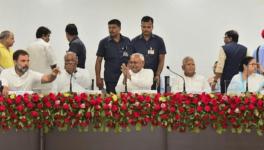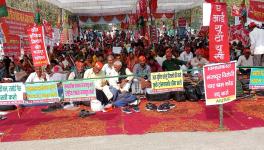COVID-19 Spread: Is Bihar Masking Ground Reality?
As Bihar gears up for the Legislative Assembly elections scheduled in October, the state is being closely watched in terms of its performance in combating the COVID-19 crisis.
As a large number of migrant workers hail from Bihar, it was anticipated that as reverse migration was happening, the cases would increase. However, it can be seen that such large-scale reverse migration by workers did not contribute to the COVID-19 cases in Bihar as migration took place mainly between March 25 to roughly May- end and the cases in Bihar started rising only after July 15.
What reverse migration did contribute to is distress among this large working population with people going without food and medical care, job losses and no compensation. As there appear to be no probable means of livelihood being generated any time soon, the situation on this front remains grim.
Floods Add to Woes
Bihar, in July and August, had to deal with an additional challenge of widespread floods. The impact of floods was concentrated in the northern districts of Bihar and it made the management of COVID- 19 pandemic difficult. As a result, during the first few weeks of August, we did see a rise in the number of new cases in districts, such as Arwal, Katihar and Saharasa.
Despite these challenges, Bihar has not done too badly on the COVID-19 pandemic front as compared to other States, though the number of confirmed cases has been rising in Bihar and is now over the 1,58,000 mark.
While in July, the state accounted for only 1.75% of the total cases reported in India, in September it accounts for about 3.6% cases. Among all the States, from its position at number 13 on July 1, Bihar worsened to a position of number 8 towards July end, but has remained at that position till the latest reported figures.
However, the relatively better parameters pertaining to the spread and incidence of COVID-19 in Bihar, which are based on official data available, might be masking much of the ground reality.
Low Spending on Health
In terms of expenditure on health, health infrastructure and human resources, Bihar has historically been underperforming which has been the result of low public expenditure on health, which stands at Rs 618 per capita per annum for 2018-19 (actual).
Reports from the ground have not just brought to light the shortages of health infrastructure, dilapidated conditions of medical facilities, overworked health workers, lack of personal protective equipment, unhygienic conditions but also exposed the gross underreporting of COVID-19-related data on testing, number of deaths and other variables.
Looking at the trend of confirmed cases in the top 10 states, we see the growth of cases in Bihar has been slower than the other states (refer Figure 1). However, given the fluctuations the spread of the pandemic has had, the trend in Bihar shows that there could be a rise in the number of cases at an increasing rate in the coming days.
Figure 1:
Looking at the rate of doubling of confirmed cases, figures for Bihar show that, as on September 12, the number of confirmed cases doubled in 33 days. Among the top 10 states, Odisha has been the worse, with confirmed cases taking just 22 days to double. For India as a whole, as on September 12, the confirmed cases had doubled in 31 days.
Table 1: Number of Days in which confirmed cases doubled in top 10 States
Note: As on Sep. 12
Looking at per week new cases against per week recovered cases, from the beginning of July till the second week of August 10-16, the number of new cases surpassed the recovered cases in Bihar. This was the period when Bihar was also struggling with the grim flood situation.
Since the third week of August, the number of recovered cases per week has been more than the number of new cases per week indicating signs of improvement. However, in the last week September 6-12, the gap between the two figures has reduced and this might turn into a worsening of the situation (refer Figure 2).
Figure 2:
If one looks at the figures for testing, there has been a sharp rise since the week ending August 2. This is the time when new tests – the antigen/antibody tests -- were approved by the Indian Council of Medical Research or ICMR that are cheaper and take much less time to give results than the more accurate RT-PCRA tests.
However, despite recording a mark of nine lakh tests in a week, Bihar remains a low in comparison to other states. The number of per million tests conducted by Bihar is much less than states such as Andhra Pradesh, Assam, Tamil Nadu. Delhi tops this list with more than one lakh tests per million of population (refer Figure 3)
Figure 3:
Note: As on September 12
As the number of tests being conducted have increased in Bihar, the positivity rate, that is, the per cent of positive tests out of the total tests, has come down. At present, the positivity rate is about 3%, which is among the lowest across states.
Figure 4:
Note: As on September 10
District-Wise Observations
A close look at the number of cases across districts shows that in the weeks following floods in Bihar, the number of new cases reported weekly increased in most of the districts (refer Figure 5). The cases surged in the weeks of August 3-9 and August 10-16 and tapered off in the following weeks. This follows the pattern observable for the state as a whole.
Figure 5:
Looking at the spread across districts, it is found that the new cases being reported per week (per lakh population) have been the highest mostly in either northern Bihar, affected by the floods, in districts such as Kishanganj, Saharsa, or in those districts which are contiguous to Patna, such as Sheikhpura, Jehanabad.
This was particularly the case during July-end and first two weeks in August. The district of Patna has consistently been the worst affected, primarily because it is one of the most densely populated districts in Bihar, second after Sheohar, and is one of the busiest urban centres.
As the impact of floods receded, there was a decline in weekly new cases per lakh population in these districts. However, since August end, a rise in these numbers across many districts can be observed. While there is a decline in the new weekly cases per lakh population in Patna and Araria, there is an increase in Lakhisarai and Gopalganj since the week of August 31- September 06. With these new districts emerging as regions of rising cases, it may be indicative of increasing geographical spread of the pandemic in Bihar.
One of the more promising parameters for Bihar has been the Case Fatality Rate (CFR). The number of deaths out of the confirmed cases has remained low. In fact, the CFR has declined in Bihar since July and is around five deaths per 1,000 confirmed cases, which is much lower than the figure for India at 17 deaths per 1,000 confirmed cases (refer Figure 6).
While this might reflect better management of serious cases, it might also be due to poor registration of deaths. A recent study by Patna University’s Population Research Centre (PRC) in collaboration with UNICEF found that only 37.1% of deaths are registered in Bihar. If we take this into account, then the Bihar figures are similar to the all-India figures.
Figure 6:
Although the above figure shows that Bihar is faring better than many other states, this needs to be corroborated with more investigations on the ground, as informal reports do suggest manipulation of data, especially in the election season. There are also protests from various health workers associations against the orders of district election officers enlisting health workers, including doctors and paramedical staff during the epidemic, for polling duty, and issuing orders for their training.
Amidst the increasing spread of COVID-19 and increasing pressure on existing health personnel, the health workers’ associations have been demanding filling up of the sanctioned positions which have been lying vacant.
As per official data, in 2018-19, against a total 8,575 sanctioned positions (regular and contractual) for doctors, there are only 4,352 doctors (regular and contractual) employed. And for Grade A nurses, against a total of 5,331 sanctioned positions (regular and contractual) in 2018-19, only 2,302 are employed.
With just four doctors per lakh population and only two Grade A nurses per lakh population, a number far below the World Health Organisation norms, the shortage of health workers is apparent, which makes the handling of a pandemic even worse.
Moreover, a large proportion of these doctors are located in only a few districts, such as Patna, Gaya, Darbhanga and Muzaffarpur. Ground reports from Bihar suggest a rather dismal and dilapidated state of health infrastructure. As per the National Health Profile there were just 10 government hospital beds (rural and urban) available per one lakh population in 2018.
Further, over the past few months, services such as mid-day meals, routine immunisation, reproductive and child healthcare services have taken a severe hit, which may increase the burden of disease manifold in the coming months. Economic activities have already spiralled down and alternative measures to generate income among the masses such as the rural job guarantee scheme MGNREGA have not been taken up by the government seriously.
With officially reported deaths due to COVID-19 in Bihar crossing the 760 mark, and the electoral fever rising, one can only hope that public health would be made a priority, both in terms of promises made in the manifestos of political parties and also while conducting the electoral exercise amid the pandemic.
The writer is associated with the Jan Swasthya Abhiyan and the People’s Health Movement.
Get the latest reports & analysis with people's perspective on Protests, movements & deep analytical videos, discussions of the current affairs in your Telegram app. Subscribe to NewsClick's Telegram channel & get Real-Time updates on stories, as they get published on our website.
























